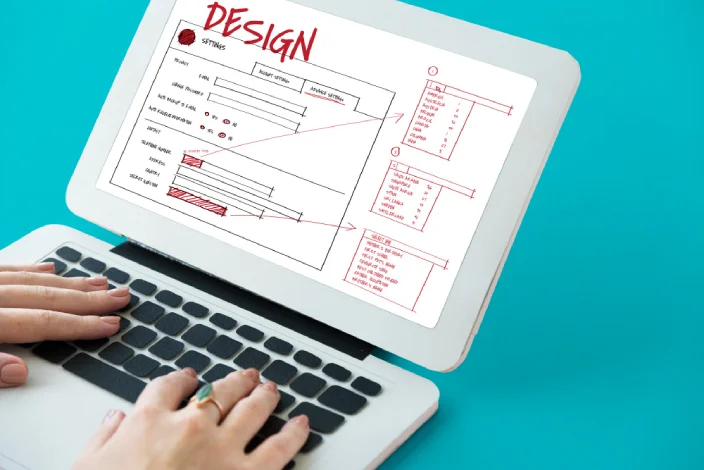
Web design can seem like a fulfilling career for many passionate designers but most people worry about its future scope and whether they’d able to break into it.
Many aspiring web designers fear pursuing a web design career only to find out it isn’t even worth it. However, this article will reassure you that web design is a great career to pursue.
In this article, we’ll discuss the demand of web designers, how much they make on average, and what skills you would need to get started. We’ll also explore the multitude of career options that lie in front of you and some web design resources to help you get started.
Are Web Designers in Demand?
Yes, web designers are highly in demand. The demand for web designers and developers is expected to grow by 23%; faster than the average of all other fields. During this period, an estimated 21,800 job openings will be generated each year.
According to the U.S. Bureau of labor statistics, this growth is expected to come as a result of growing ecommerce and mobile users. As more businesses are offering their products/services online, the need of web designers grows to develop an attractive site for their customers.
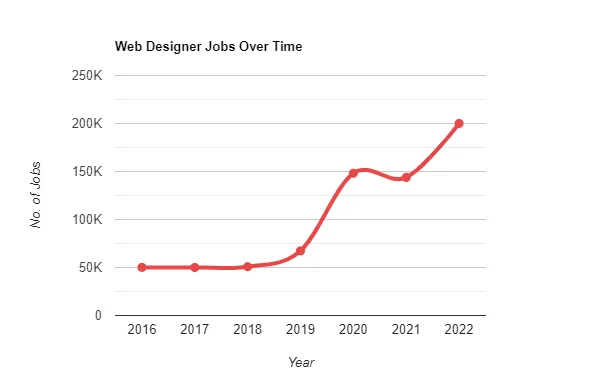
As highlighted from the graph above, web designer jobs from 2016 to 2022 have risen expotentially. In 2016, there were around 50,117 web designer jobs (source) and this number rised to 200,064 in 2022 (source). That’s a 74.9% growth in web designer jobs!
However, as the market has evolved, web designers also need to evolve. Nowadays, the web isn’t as simple as it was back when it first launched. Now, knowledge of responsive design and coding is a must, so they can meet the increased demand and remain competitive.
Do Web Designers Get Paid Well?
Generally, web designers are paid higher than most professions. The average salary of a web designer is $62,323, but how much you make depends on various factors like place and experience as well. In the below graph you can see how the average web designer’s salary has consistently risen over time.
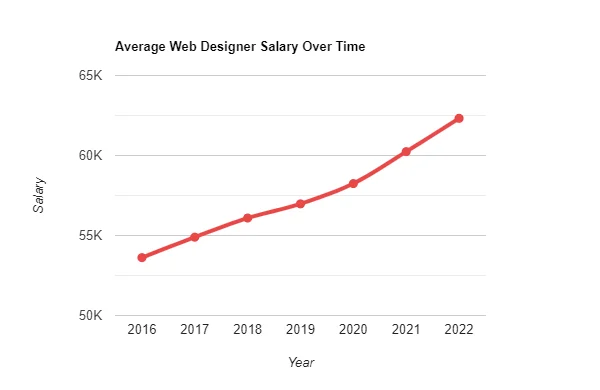
The average web designer salary in 2016 was $53,616 per year or $25.78 per hour. This figure increased by 13.9% in 2022 making the average web designer salary around $60,000 to $70,000 (source).
Experience also matters as junior web designers make around $45,000 to $53,000. Whereas, senior web designers tend to get paid an average of $82,000 and more. Management positions are estimated to be paid the highest in the with average salaries ranging from $120,000 to $180,000+ (source)
Specializing in a specific field with high demand also enables designers to make more than the average web designer. For example, senior product designers, UX designers, and visual designers make upwards of $100,000 which is 18% more than the average salary of a senior web designer.
The place also matters as different countries/cities may pay more or less.
Research from Hongkiat identified the top 5 highest and lowest paying countries for web designers. Below is a summary of their findings:
| Country | Annual Salary |
|---|---|
| Switzerland | $77,530 |
| Australia | $52,351 |
| New Zealand | $48,156 |
| Germany | $47,245 |
| Sweden | $43,526 |
| Country | Annual Salary |
|---|---|
| Argentina | $8,930 |
| Egypt | $6,227 |
| Kenya | $6,192 |
| Indonesia | $4,305 |
| India | $3,364 |
In the U.S. the average web designer salary is $48,867 but this also varies from city to city. California pays the highest, with some web designers earning 20% higher than designers located in other states.
Is Web Designing Hard to Learn?
A few years ago, web designing was easy to learn, but due to increasing requirements, it’s becoming complex. However, thanks to advances in technology and an increase in web design resources it’s easy to learn web design nowadays.
You can start learning web design at home by teaching yourself through YouTube videos and courses (which we’ll discuss in detail below.) Alternatively, you can enroll in a design school or university.
If you have the passion and interest in learning about how the web works, the principles of design, and collaborating with others, web design can be a fulfilling career.
What Skills Do You Need to Start a Web Design Career?

To get started in web design, you need a set of technical skills and soft skills. Technical or hard skills deal with skills specific to your field like layout design, visual design, and SEO, etc. Soft skills on the other hand are personal traits that enable a person to work together as a team.
Below we’ll discuss both types of skills and where to get started:
Visual Design
Visual design encompasses everything from design principles, layout techniques, and typography. Web designers need to have a firm grasp on visual design to create effective designs and enhance the look and feel of a website.
Visual design is a broad term and includes a lot of things. The things you’ll be learning about would include typography, layout techniques, color theory, color psychology, grid systems, and proportions.
User Experience (UX) Design
Although UX design is broad enough to be a field of its own, every web designer needs to know the fundamentals of UX design to create user-centric designs that resonate with the target audience.
The ability to think from the user’s perspective and create web designs that flow naturally with the viewer’s eyes are the essence of good UX design. Bad UX design contributes to a negative impression of a website and may lead to more people clicking off a site.
Coding Knowledge
Knowledge of coding languages is becoming more and more important for web designers as the demand for web designers rises and the market gets competitive. Nowadays, apart from design principles, web designers are expected to learn HTML, CSS, and a little bit of Javascript.
These coding languages are what make up the bulk of the web. Having a good understanding of coding will help you understand how the web works and how design elements are displayed on a website. Although getting too in-depth with front-end development isn’t necessary, knowing a few basic coding languages definitely helps in finding a job sooner.
Learning to code will also make it easier to collaborate with developers and effectively work with them to create awesome looking, functional websites. Since teamwork is a valuable skill for any organization, catching up with web developers will definitely increase your value in the eyes of future employers.
Using Design Software
Web design is as old as the web itself, as web designers have come a long way, they’re skills have evolved. To incorporate the evolution of the web designer’s creativity, web design tools and software now include a plethora of features to help you create innovative and expressive designs.
Because of this, design software tends to have a steep learning curve and even experienced designers are not fully sure of what every feature does. Having a grasp on industry-standard software like Adobe XD, Figma, or Sketch can streamline your workflow and make you more productive – which is an invaluable skill for any profession.
Basics of SEO
SEO stands for search engine optimization, its main aim is to make a website easier to discover for search engines so it ranks higher in results. Designers should take SEO into account when making their designs to make decisions that would not only make a company’s website look good but rank higher in search engines.
Web designers and web developers often clash because of conflicting views on SEO. A web designer might be tasked to make the site look good whereas web developers might be responsible for making the site load faster and stay functional.
Web designers would use design assets that would enhance the look and feel of the website but may compromise on speed – which is inherently bad for SEO. That’s why learning the basics of SEO can lead to better decision making and effective collaboration with other departments.
The above technical skills need to be complemented with a set of soft skills to ensure you’re able to work effectively with others and on your own. Below are a set of essential soft skills every web designer needs.
Time Management
Managing your time effectively is essential for hitting deadlines, developing a routine, and staying productive. Good time management skills would ensure you have an effective workflow and are able to meet project needs in time.
As more businesses are becoming agile, they might require designers to be flexible with their timing and adapt to changing customer trends and market dynamics quickly and efficiently.
Attention to Detail
A web designer needs to have a keen eye for details since every web design element needs to flow well. Minor details and subtle effects can have a big effect on users, visitors, or readers and could contribute to a higher bounce rate if taken lightly.
Web designers should be quick to point out inefficiencies and minor flaws in a website’s design to ensure the best design is put forward.
Communication Skills
Communication skills in any creative field is necessary to effectively convey your ideas. Being able to convey your ideas in a way that is easily understood would ensure everyone’s on the same page and that they understand the “science” behind a design.
Also, communication in every field is important as people are expected to effectively collaborate with each other. Teamwork is always better than going at a project solo, so the ability to effectively communicate with others is a valuable skill to have.
How Long Will it Take to Learn Web Design?
How long it takes to become a web designer depends on the path you choose to learn web design.
If you pursue a web design degree, then a bachelor’s degree would take you 4 years to complete and pursuing a master’s degree after that, would take an additional 2 years. It’s also possible to enroll in an online course, preferably one that’s highly recognized, which might take 3-6 months to complete.
The best way of learning web design is by applying what you learn by creating real projects, whether fictional or actual client projects. Creating web designs from scratch is the best way to learn and apply your learning, which will also help you build your portfolio and increase your chances of getting a job.
Web Design Career Paths: Exploring Your Options
There are many different career paths to explore within the web design space. This may include:
- UI/UX Designer
- Visual Designer
- Product Designer
- Front-end Developer
Although you can choose to specialize in a specific design field, a typical web design career path looks like this:
You start off as a junior designer, either as an intern or trainee, and will work closely with an experienced web designer to give you an idea of the work. The experienced designer might train you to develop your web design skills, understand business objectives, and help you discover your place in the organization. During this period, you won’t be expected to take on much responsibility.
After a few months, you’ll be promoted as a web designer that actively works as a team on projects. At this stage, you’ll be more hands-on and also partake in decision making. You’ll be expected to take on responsibilities like sketching out ideas, designing the interface, or collaborating with web developers.
After a few years, you’ll be promoted to senior web designer and your responsibilities will increase. You’ll be expected to lead client meetings, gather requirements for projects, and participate in stakeholder meetings. You would update managers on progress, create performance reports, and work together with other web designers in an authoritative position.
After gaining considerable experience in web design, web designers typically branch out to one of two types of career paths: either they choose a managerial role or transition to another similar career.
Choosing a managerial role is a great choice for those who plan on settling down and are comfortable supervising large teams in enterprises. You won’t be doing a lot of active hands-on web design but would rather act as a mentor and guide to a team of web designers.
Transitioning to another branch of web design might be more fulfilling for those who are curious and love to keep learning newer techniques and experiment with the latest web design tools. If you go down this path, you’d most probably be interested in learning about web development which would nicely complement your web design skills.
Web Design Resources to Help You Get Started
If you’ve decided that web design would be a good career choice for you, then you’d need some resources to help you get started.
Below, we’ve discussed some courses and books to help you understand the basics, build a portfolio, and polish your skills to improve your web design knowledge and get a headstart in your career.
1. Google UX Design Course
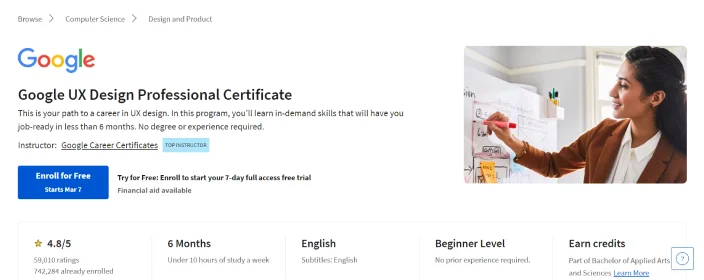
The Google UX Design course by Coursera guides you through everything you need to know to get started as a UX designer. It’s a beginner level course that takes about 6 months to complete (although you can progress at your own pace.)
There are no requirements before starting, you don’t need a degree or previous experience as this course will guide you from the very beginning and get you job-ready by the end of it.
Google’scertification would be recognized by most companies as it’s a highly popular and reputable brand.
They also have a detailed approach to web design as they won’t just teach you how to make websites look nice but guide you through on how to conduct user testing, create wireframes and prototypes, and create a professional UX portfolio with 3 projects: a mobile app, a responsive website, and a cross-platform experience.
2. Web Design for Everybody by University of Michigan
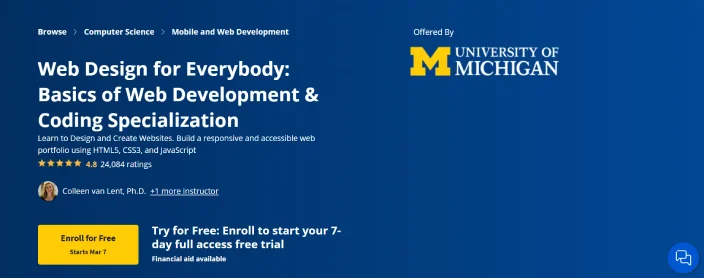
Another excellent web design course by Coursera is the Web Design for Everybody course by University of Michigan. In contrast to the Google UX Design course, this course has a higher focus on front-end web development and responsive design.
This course will help you specialize in HTML, CSS, and Javascript as well as help you create a professional level portfolio with responsive web design elements. It also goes in-depth into creating detailed document outlines, writing “correct” HTML and CSS, and making your designs accessible so they’re available to a larger audience.
3. Webflow University’s Ultimate Web Design Course
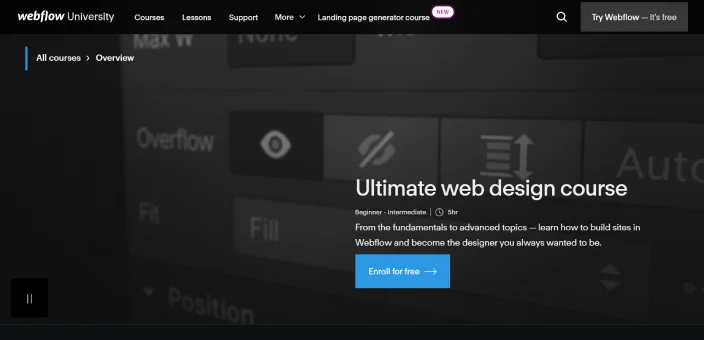
Webflow University’s Ultimate Web Design course is a totally free course that teaches you the basics of web design and patterns. This course provides a hands-on approach to web design as it teaches you how to create common design patterns and techniques.
A unique thing about this course from others is that it also introduces you to content management systems (CMSs.) As more businesses are using a CMS to create no or low-code websites, learning about them is important for web designers.
However, this course limits its teaching to the Webflow CMS rather than teaching you about the more popular CMS, WordPress – which is used by 43.2% of the entire web.
4. Refactoring UI – Book by Adam Wathan and Steve Schoger
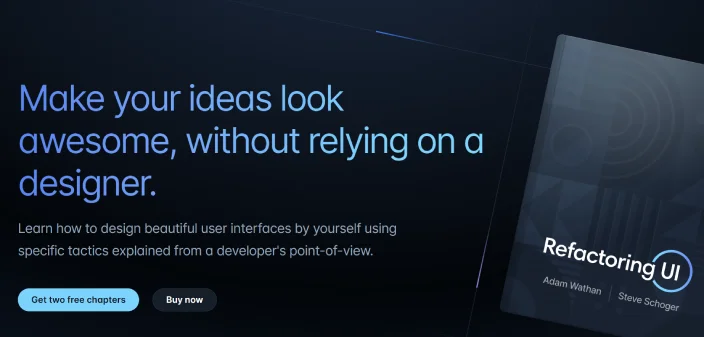
This book on web design is a powerful resource to help you streamline your UI/UX designs. Refactoring UI is written by Adam Wathan and Steve Schoger, one a talented web developer and the latter an experienced web designer.
In the book they go through the fundamentals of web design, common web design mistakes and their solutions, and actionable tips to instantly improve your designs. The book is expensive – starting from $99 – but is well worth it for the value you get.
5. Code Academy
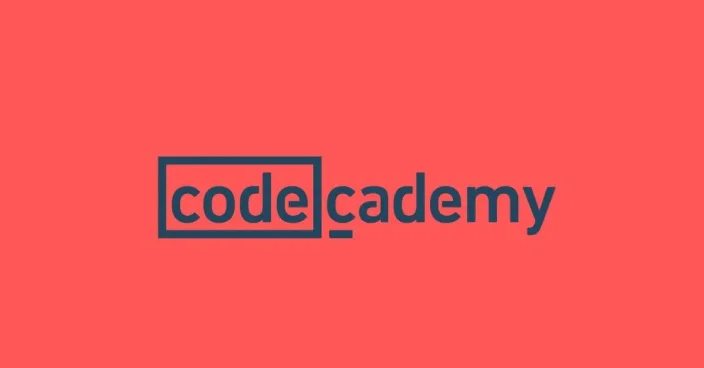
We’ve discussed multiple times throughout this article that web design is not just about designing but also building attractive websites. Code Academy is a great resource to start learning the basics of HTML, CSS, and Javascript. An understanding of front-end web development from here will give you a headstart in web design and make you a valuable asset for future employers.
They offer a range of free tutorials, courses, and career paths. What I love about their website is that they categorize their courses with the following options: Free, New to Coding, Most Popular, Skill Paths, Career Paths.
This makes it easier to know where to start and what course to enroll in for confused first-timers.
6. FreeCodeCamp
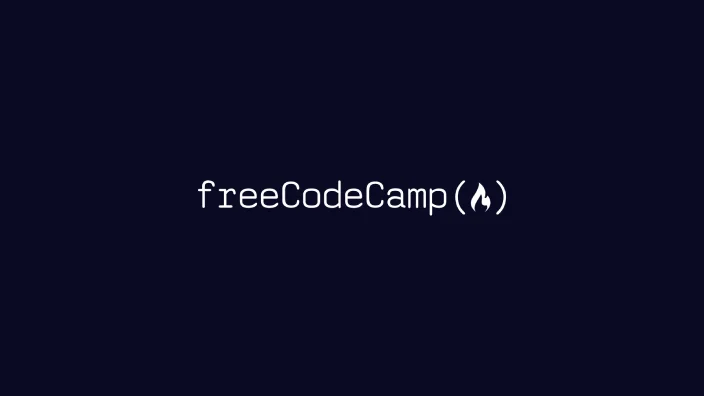
FreeCodeCamp has been providing timeless value for years for free. You can find lengthy 2, 4, and sometimes even 10-hour tutorials on their YouTube channel which help you specialize in a coding language discussing everything there’s to know
It’s been mentioned by countless big names like BBC, Quartz, INC. Business Insider, Wired, and many more. Their students have also managed to land jobs in Google, Apple, and Microsoft with their free certifications and programs.
I truly appreciate your technique of writing a blog. I added it to my bookmark site list and will